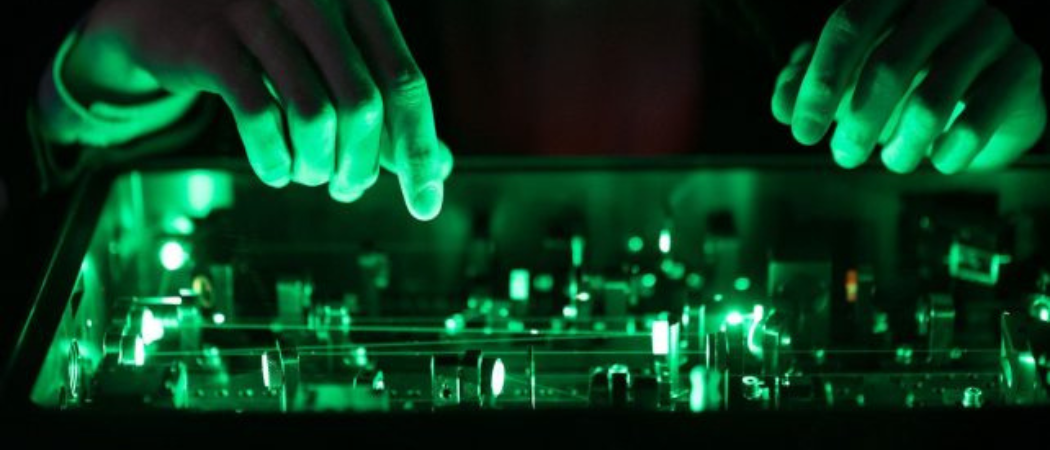Already punching above its weight, Lithuania’s laser sector is looking for new avenues to growth
Lithuania’s laser ecosystem is remarkably strong. Underpinned by an academic centre of excellence at the University of Vilnius, it has grown dramatically over the past two decade to cover almost the entire value chain. The challenge it faces now remove barriers to further growth, such as workforce shortages, and to enter new markets.
The seed of Lithuania’s laser ecosystem is the Laser Research Centre in the Faculty of Physics at Vilnius University. Established in the mid-1980s, it produced its first spin-off company, Light Conversion, in 1994. Others followed, and in time produced spin-offs of their own.
“The ecosystem is still growing. Twenty-five years ago we had around 20 companies, and now we have 60 companies,” said Kristina Ananičienė, executive director of the Lithuanian Laser Association.
Start-ups tend to emerge from publicly funded R&D projects, or when employees within the ecosystem decide to strike out on their own. “Typically during a year we see one or two new companies established, but some years we have none and some we have three or four,” she said.
Coverage has also grown in the past decade or so. “Before you might have a laser manufacturer, a mechanics manufacturer and an optics manufacturer, but not the whole value chain,” said Antanas Laurutis, chief executive of Altechna, one of the sector’s earliest start-ups. “Now you can find materials suppliers, sub-component suppliers, device and system providers, and system users. The only thing we lack are large end-users.”
In order to find these end users, for example in the automotive industry, medical devices or semiconductors, Lithuania’s laser companies need to look abroad. “If you look at other centres around the world, such as Silicon Valley in California, you can find everything there,” Laurutis said. “The same goes for Japan, or Jena in Germany. So the next step for Vilnius would be to get an end user.”
Ananičienė also sees this lack of large customers as a weakness in the Lithuanian laser ecosystem. “When you don’t have the end user or potential client it is harder to make connections and do rapid product development work,” she said. The flip side of this is that Lithuania’s laser start-ups are born with an export mentality. “It’s a problem, but it also makes our companies more global.”
While the more mature companies in the ecosystem tend to focus on broadly applicable laser or optical systems, others are more focused. “There are more and more companies going for a particular application field, such as defence, quantum communications or 3D bio-printing,” Ananičienė said.
Defence applications are both attractive and challenging. “It’s a very specific sector, with its own particular requirements, but with the geopolitical situation in Europe and the world, it has become more of an opportunity,” said Laurutis. “I see a lot of start-ups looking at this area, and at Altechna we are looking more and more at defence applications and possible projects to develop products.”
This trend will stimulate other parts of the laser market. “Some companies are now completely focusing on defence, so gaps are appearing in other markets that are opportunities for others,” Laurutis said.
However, dual use development is not that common, according to Ananičienė. “Companies tend to choose to be either in defence or in civil applications,” she said. “It gets a bit tricky for one company to fulfil the legal obligations and value chain roles in both of those fields.”
For Laurutis, the scope for dual use depends on a company’s focus. “If you are making a final product you either need to be in defence or not, but at a component level it is entirely possible to do both,” he said.
Growth and diversification
Altechna has gone through several changes since was founded in 1996. Initially specialising in laser optics and coatings for research and industry, in 2007 it span off a group of projects in laser micromachining as Altechna R&D, now better known under the brand Workshop of Photonics. In 2016, the company strategy shifted to focus on strategic partnerships developing photonics solutions.
It has a subsidiary in China, and in November 2023 acquired Alpine Research Optics, a US-based producer of laser optics for UV applications. In addition to strengthening its presence in the US market, this pointed to a different way for the business can grow.
“In our industry, to develop a new technology can take decades, and working organically in that way means you either need to be extremely successful or extremely lucky if you want to grow rapidly,” Laurutis said.
The next challenge is to find an acquisition target that will deliver more value to customers. “We’re looking at different technologies and exciting niche markets, such as quantum computing and new medical and semiconductor applications.”
At the other end of the spectrum are start-ups like Beamera, founded in 2021 by Saulius Milkintas, a former head of R&D at a Lithuanian photonics company, who spotted an opportunity to improve the design of laser beam expanders and laser objectives for micromachining. When the company he was with decided the niche was not a priority, he decided to do it alone.
Beginning with support from a government funding scheme, Beamera quickly acquired customers, allowing it to develop further without needing venture capital investment. “What we are doing is not that disruptive, it’s just making things differently, and all you need to do that is knowledge and experience,” Milkintas said. “Therefore we decided to rely on ‘sweat equity’ rather than equity investment.”
The concentration of laser activity in and around Vilnius was a positive factor in creating the company. “Perhaps I could have started Beamera elsewhere, but it would not have been as successful,” he said. “The atmosphere here is really positive, so if you need anything you can ask and companies are willing to help, even competitors. That’s because of the community spirit and personal relationships that we have.”
And he sees a lot of potential in Beamera’s chosen niche. “We’ve positioned ourselves as a manufacturer of optics that sit between the laser and the sample in the laser machining process,” he said. “We now have several products in that track, and there is plenty more we can do.” Beyond that, the technology may also find applications in areas such as 3D printing.
A well-supported ecosystem
Investment for Lithuania’s laser companies is not abundant, but it is available. “Even the smaller companies have possibilities to raise funding from agencies and business angels, and some of the bigger companies also invest in start-ups,” Ananičienė said.
That said, the laser sector faces the familiar challenge of finding patient investors willing to take the long view. Altechna has been particularly successful on this front, securing backing from venture capital firm LitCapital, which in 2020 acquired full ownership of the company.
Meanwhile, the Lithuanian government is supportive. “We have quite a good legal and financial basis for new companies, and the government can sometimes put funding towards start-ups and new product development,” said Ananičienė.
However, the bureaucracy involved in these programmes can often be a burden for small companies. “Simplification of product development and concept development projects would be really helpful, especially for start-ups,” Milkintas said.
The government has also been supporting trade missions to South Korea and Taiwan, activities which the Lithuanian Laser Association helps organise. Taiwan is a particularly attractive partner. “We can see the synergy between our ecosystem and what the Taiwanese can do with our technology and knowledge, the potential for up-scaling and working with potential end-users that are hard for us to reach.”
Laurutis agrees. “There are some countries where government participation is not necessary, culturally, and other countries where it is a must. For Taiwan and South Korea it really helps, and both countries are huge in most of the target markets for the Lithuanian laser community.”
Talent for growth
A more significant structural issue is skills. “We mostly hire from Vilnius University’s Faculty of Physics, and most of the other companies do the same,” said Laurutis. “The specialists they prepare are exactly what we are looking for.”
But supply is not keeping up with demand, so companies are having to look elsewhere. Other institutions, such as Kaunas University of Technology, are increasingly making a contribution, and companies are working on initiatives to help people from other sectors retrain for the laser industry.
“At the beginning we used physicists for everything, but now we are adapting so that we are no longer looking for PhDs to assemble systems,” said Laurutis.
Beamera found its three staff locally, two from the industry and one just out of academia. “But it seems as if the number of physicists graduating each year is decreasing,” Milkintas said. “That’s the main limitation on the emergence of new start-ups, and it would be very helpful if the government paid more attention to natural sciences like physics and chemistry education at school.”
Ananičienė would also like to see more attention given to education leading to a career in lasers. “We would like to create a complete learning pathway for optical science that leads from high school, through technical schools and on to higher education,” she said.
For R&D, Vilnius University remains an important source for the sector, although relationships change as companies mature. Altechna, for example, has its roots in the university’s Laser Research Centre, but its research activity has diversified, particularly when it comes to EU-funded projects. “Altechna now has a lot of R&D projects internally, or in collaboration with international centres, such as Laser Zentrum Hannover and others,” he said.
Milkintas, on the other hand, feels that some of the value generated by Vilnius University is frustratingly out of reach. “I see the potential of the research going on in the university, but the investment needed to commercialise it can be as high as seven digits, and as a start-up we don’t have that kind of money,” he said. “Even though there is some science to business collaboration in photonics, it is business-driven. More could be done to turn topics that are scientist-driven into start-ups, because a lot of this promising research just ends up filed away in a drawer.”
While Laurutis thinks there is scope for further new start-ups in the Vilnius ecosystem, the emphasis is more likely to be on growth and consolidation.
“Some of the existing start-ups have been in the market for five to ten years, so I’d expect some to really go up, while others drop out,” he said. “I don’t expect to see a lot of new start-ups, but I do expect to see some consolidation in future, and bigger players emerging in the Lithuanian industry.”
- Fund-of-funds investor PFR Ventures is to put around €47 million into four venture capital funds supporting Polish start-ups. These are the first awards under the European Funds for a Modern Economy programme, with 12 further bids still under consideration. The funds will be managed by 24Ventures, Digital Ocean Ventures Starter, Hard2beat, and Tar Heel Capital Pathfinder, in areas such as artificial intelligence, digital transformation, clean tech, med tech and cybersecurity.
- Romanian start-up Ogre AI has closed a €3 million investment round that will support further development of its forecasting tools for the renewable energy sector and expansion in new European markets. The round was led by Verbund X Ventures, with contributions from Sofia Angels Ventures, Soulmates Ventures, MMC Greater London Fund and Early Game Ventures.
- The European Commission and the European Patent Office are to step up their collaboration so that intellectual property is considered throughout the innovation process, from project finding to commercialisation. The agreement foresees initiatives such as joint awareness campaigns, training and events to highlight the importance of intellectual asset management, initiatives to boost the potential of start-ups, and information exchange on innovation trends.






 A unique international forum for public research organisations and companies to connect their external engagement with strategic interests around their R&D system.
A unique international forum for public research organisations and companies to connect their external engagement with strategic interests around their R&D system.